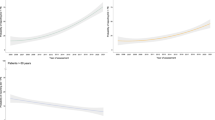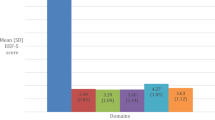Abstract
This study aims to describe the incidence rate of erectile dysfunction (ED) in older men in the Netherlands according to three definitions. The influence of the duration of follow-up on the incidence rate is also explored. In a large community-based follow-up study, 1661 men aged 50–75 y completed the International Continence Society sex questionnaire and a question on sexual activity, at baseline and at a mean of 2.1 and 4.2 y of follow-up. We defined ‘ED’ as a report of erections with ‘reduced rigidity’ or worse; ‘Significant_ED’ as ‘severely reduced rigidity’ or ‘no erections’; and ‘Clinically_Relevant_ED’ as either ‘ED’ reported as ‘quite a problem’ or ‘a serious problem’, or ‘Significant_ED’ reported as at least ‘a bit of a problem’. Incidence rates of ED status were calculated in those men who completed at least one period of follow-up and were not diagnosed with prostate cancer (n=1604). For ‘ED’ the incidence rate (cases per 1000 person-years) is 99 and ranges over the 10-y age groups from 77 (50–59 y) to 205 (70–78 y); for ‘Significant_ED’ these rates were 33, 21, and 97, respectively and for ‘Clinically_Relevant_ED’ 28, 25, and 39, respectively. In general, incidence rates should not vary with the duration of follow-up. However, for ‘ED’ the 4.2 y incidence rate is about 69% of the 2.1 y incidence rate. This study presents incidence rates, for the general population, as well as based on a definition of ED that takes concern/bother into account. ‘Clinically_Relevant_ED’ has a lower increase in incidence with increasing age than other definitions that do not take concern/bother into account. The phenomenon of lower incidence rates with longer duration of follow-up may account for the differences in reported incidence rates between different studies. The effects of differences related to the duration of follow-up should be taken into consideration in future incidence reports.
This is a preview of subscription content, access via your institution
Access options
Subscribe to this journal
Receive 8 print issues and online access
$259.00 per year
only $32.38 per issue
Buy this article
- Purchase on Springer Link
- Instant access to full article PDF
Prices may be subject to local taxes which are calculated during checkout

Similar content being viewed by others
References
Kubin M, Wagner G, Fugl-Meyer AR . Epidemiology of erectile dysfunction. Int J Impot Res 2003; 15: 63–71.
Wagner G, Saenz de Tejada I . Update on male erectile dysfunction. BMJ 1998; 316: 678–682.
Hengeveld MW, Gianotten WL . [Erectile disorders: the reality] Erectiestoornissen: de actuele situatie. Ned Tijdschr Geneeskd 2001; 145: 1381–1384.
Johannes CB et al. Incidence of erectile dysfunction in men 40–69 years old: longitudinal results from the Massachusetts male aging study. J Urol 2000; 163: 460–463.
Aytac IA et al. Socioeconomic factors and incidence of erectile dysfunction: findings of the longitudinal Massachussetts Male Aging Study. Soc Sci Med 2000; 51: 771–778.
Moreira ED et al. Incidence of erectile dysfunction in men 40–69 years old: results from a population-based cohort study in Brazil. Urology 2003; 61: 431–436.
Shiri R et al. Effect of chronic diseases on incidence of erectile dysfunction. Urology 2003; 62: 1097–1102.
Blanker MH et al. Erectile and ejaculatory dysfunction in a community-based sample of men 50–78 years old: prevalence, concern, and relation to sexual activity. Urology 2001; 57: 763–768.
Prins J et al. Prevalence of erectile dysfunction: a systematic review of population-based studies. Int J Impot Res 2002; 14: 422–432.
Blanker MH et al. Strong effects of definition and nonresponse bias on prevalence rates of clinical benign prostatic hyperplasia: the Krimpen study of male urogenital tract problems and general health status. BJU Int 2000; 85: 665–671.
Frankel SJ et al. Sexual dysfunction in men with lower urinary tract symptoms. J Clin Epidemiol 1998; 51: 677–685.
Blanker MH et al. Prostate cancer detection in older men with and without lower urinary tract symptoms: a population-based study. J Am Geriatr Soc 2003; 51: 1041–1042.
Faris PD et al. Multiple imputation versus data enhancement for dealing with missing data in observational health care outcome analyses. J Clin Epidemiol 2002; 55: 184–191.
Hopke PK, Liu C, Rubin DB . Multiple imputation for multivariate data with missing and below-threshold measurements: time-series concentrations of pollutants in the Arctic. Biometrics 2001; 57: 22–33.
Kmetic A, Joseph L, Berger C, Tenenhouse A . Multiple imputation to account for missing data in a survey: estimating the prevalence of osteoporosis. Epidemiology 2002; 13: 437–444.
Landrum MB, Becker MP . A multiple imputation strategy for incomplete longitudinal data. Stat Med 2001; 20: 2741–2760.
Schafer JL, Graham JW . Missing data: our view of the state of the art. Psychol Methods 2002; 7: 147–177.
Rubin DB, Schenker N . Multiple imputation in health-care databases: an overview and some applications. Stat Med 1991; 10: 585–598.
Taylor JM et al. Use of multiple imputation to correct for nonresponse bias in a survey of urologic symptoms among African-American men. Am J Epidemiol 2002; 156: 774–782.
Stijnen T, Arends LR . Roaming through methodology. XVI. What to do about missing data. Ned Tijdschr Geneeskd 1999; 143: 1996–2000.
SAS system for Windows [Windows version 5.0.2195 program]. Release 8.2 TS Level 02M0 Version. SAS Institute Inc.: Cary, NC, USA, 2001.
IVEware [program]. 2.0 version. Michigan: Survey Research Center, Institute for Social Research. University of Michigan, 2002.
Kaye JA, Jick H . Incidence of erectile dysfunction and characteristics of patients before and after the introduction of sildenafil in the United Kingdom: cross sectional study with comparison patients. BMJ 2003; 326: 424–425.
Masumori N et al. Decline of sexual function with age in Japanese men compared with American men—results of two community-based studies. Urology 1999; 54: 335–344, discussion 344–345.
Panser LA et al. Sexual function of men ages 40–79 years: the Olmsted County Study of Urinary Symptoms and Health Status Among Men. J Am Geriatr Soc 1995; 43: 1107–1111.
Author information
Authors and Affiliations
Corresponding author
Appendix 1
Appendix 1
Rights and permissions
About this article
Cite this article
Schouten, B., Bosch, J., Bernsen, R. et al. Incidence rates of erectile dysfunction in the Dutch general population. Effects of definition, clinical relevance and duration of follow-up in the Krimpen Study. Int J Impot Res 17, 58–62 (2005). https://doi.org/10.1038/sj.ijir.3901264
Received:
Accepted:
Published:
Issue Date:
DOI: https://doi.org/10.1038/sj.ijir.3901264
Keywords
This article is cited by
-
The spreading information of YouTube videos on Phosphodiesterase 5 inhibitors: a worrisome picture from one of the most consulted internet source
International Journal of Impotence Research (2023)
-
Health and lifestyle factors associated with sexual difficulties in men – results from a study of Australian men aged 18 to 55 years
BMC Public Health (2016)
-
Erectile dysfunction
Nature Reviews Disease Primers (2016)
-
Erectile dysfunction prospectively associated with cardiovascular disease in the Dutch general population: results from the Krimpen Study
International Journal of Impotence Research (2008)



